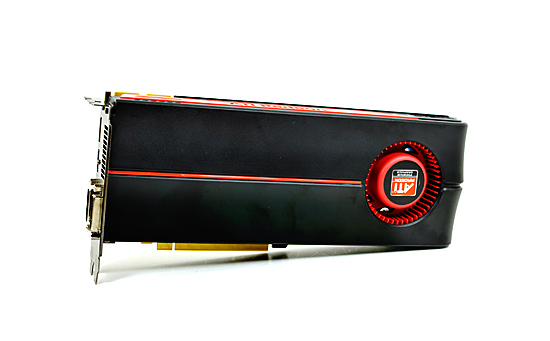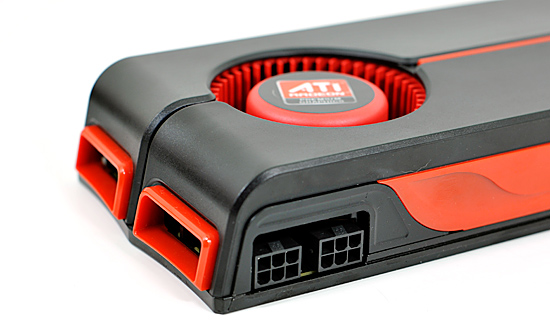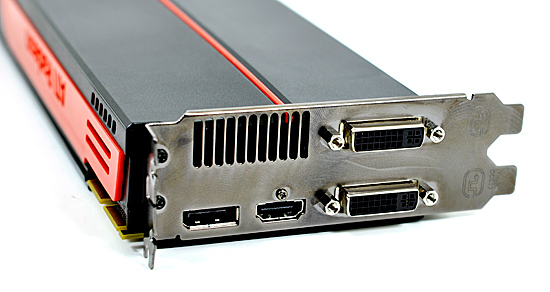AMD's Radeon HD 5870: Bringing About the Next Generation Of GPUs
by Ryan Smith on September 23, 2009 9:00 AM EST- Posted in
- GPUs
Meet the 5870
The card we’re looking at today is the Radeon HD 5870, based on the Cypress core.

Compared to the Radeon HD 4870, the 5870 has seen some changes to the board design. AMD has now moved to using a full sheath on their cards (including a backplate), very much like the ones that NVIDIA has been using since the 9800GTX. The card measures 10.5” long, an inch longer than the 4890 or the same as the 4870x2 and the NVIDIA GTX lineup.
The change in length means that AMD has moved the PCIe power connectors to the top of the card facing upwards, as there’s no longer enough room in the rear. Facing upwards is also a change from the 4870x2, which had them facing the front of the card. This, in our opinion, makes it easier to plug and unplug the PCIe power connectors, since it’s now possible to see what you’re doing.
Since the card has a TDP of 188W, AMD can still get away with using two 6-pin connectors. This is going to be good news for those of you with older power supplies that don’t feature 8-pin connectors, as previously the fastest cards without 8-pin connectors were the 4890 and GTX 285.

Briefly, the 5850 that we are not testing today will be slightly smaller than the 5870, coming in at 9.5”. It keeps the same cooler design, however the PCIe power connectors are back on the rear of the card.
With the 5800 series, DisplayPort is getting a much-needed kick in the pants. DisplayPort (full size) is standard on all 5800 series cards – prior to this it has been rather absent on reference cards. Along with a DisplayPort, the 5870 reference card contains a dedicated HDMI port, and a pair of DVI ports.
Making 4 ports fit on a card isn’t a trivial task, and AMD has taken an interesting direction in making it happen. Rather than putting every port on the same slot of the bracket as the card itself, one of the DVI ports is raised on to the other bracket. ATI could have just as easily only equipped these cards with 1 DVI port, and used an HDMI-to-DVI adapter for the second port. The advantage of going this direction is that the 5800 series can still drive two VGA monitors when using DVI-to-VGA adapters, and at the same time having an HDMI port built in means that no special adapters are necessary to get an HDMI port with audio capabilities. The only catch to this specific port layout is that the card still only has enough TMDS transmitters for two ports. So you can use 2x DVI or 1x DVI + HDMI, but not 2x DVI + HDMI. For 3 DVI-derived ports, you will need an active DisplayPort-to-DVI adapter.
With the configuration AMD is using, fitting that second DVI port also means that the exhaust vent of the 5800 series cards is not the full length of the card as is usually common, rather it’s a hair over half the length. The smaller size had us concerned about the 5870’s cooling capabilities, but as you’ll see with our temperature data, even with the smaller exhaust vent the load temperatures are no different than the 4870 or 4850, at 89C. And this is in spite of the fact that the 5870 is rated 28W more than the 4870.

With all of these changes also comes some changes to the loudness of the 5870 as compared to the 4870. The 27W idle power load means that AMD can reduce the speed of the fan some, and they say that the fan they’re using now is less noticeable (but not necessarily quieter) than what was on the 4870. In our objective testing the 5870 was no quieter than any of the 4800 series cards when it comes to idling at 46.6dB, and indeed it’s louder than any of those cards at 64dB at load. But in our subjective testing it has less of a whine. If you go by the objective data, this is a push at idle and louder at load.
Speaking of whining, we’re glad to report that the samples we received do not have the characteristic VRM whine/singing that has plagued many last-generation video cards. Most of our GTX cards and roughly half of our 4800 series cards generated this noise under certain circumstances, but the 5870 does not.
Finally, let’s talk about memory. Despite of doubling just about everything compared to RV770, Cypress and the 5800 series cards did not double their memory bandwidth. Moving from the 4870 and it’s 900MHz base memory clock, the 5870 only jumps up by 33% to 1.2Ghz, in effect increasing the ratio of GPU compute elements to memory bandwidth.
When looking back at the RV770, AMD believes that they were not bandwidth starved on the cards that used GDDR5. And since they had more bandwidth than they needed, it was not necessary to go for significantly more bandwidth for Cypress. This isn’t something we can easily test, but in our benchmarks the 5870 never doubles the performance of the 4870, in spite of being nearly twice the card. Graphics processing is embarrassingly parallel, but that doesn’t mean it perfectly scales. The different may be a product of that or a product of the lack of scaling in memory bandwidth, we can’t tell. What’s for certain however is that we don’t have any hard-capped memory bandwidth limited situations, the 5870 always outscores the 4870 by a great deal more than 33%.










327 Comments
View All Comments
Wreckage - Wednesday, September 23, 2009 - link
Hot, loud, huge power draw and it barely beats a 285.A disappointment for sure.
SiliconDoc - Thursday, September 24, 2009 - link
Thank you Wreckage, now, I was going to say draw up your shields, but it's too late, the attackers have already had at it.--
Thanks for saying what everyone was thinking. You are now "a hated fanboy", "a paid shill" for the "corporate greedy monster rip off machine", according to the real fanboy club, the ones who can't tell the truth, no matter what, and prefer their fantasiacal spins and lies.
Zstream - Wednesday, September 23, 2009 - link
They still allow you to post?yacoub - Wednesday, September 23, 2009 - link
He's right in the first sentence but went all fanboy in the second.Griswold - Wednesday, September 23, 2009 - link
Not really, he's a throughbred fanboy with everything he said. Even on the "loud" claim compared to what previous reference designs vom ATI were like...SiliconDoc - Wednesday, September 30, 2009 - link
So if YOU compare one loud design of ati's fan to another fan and as loud ati card( they're all quieter than 5870* but we'll make believe for you for now),
and they're both loud, anyone complaining about one of them being loud is "an nvidia fanboy" because he isn't aware of the other loud as heck ati cards, which of course, make another loud one "just great" and "not loud". LOL
It's just amazing, and if it was NV:
" This bleepity bleep fan and card are like a leaf blower again, just like the last brute force monster core power hog but this **tard is a hurricane with no eye."
But since it's the red cards that are loud, as YOU pointed out in the plural, not singular like the commenter, according to you HE's the FANBOY, because he doesn't like it. lol
ULTIMATE CONCLUSION: The commenter just told the truth, he was hoping for more, but was disappointed. YOU, the raging red, jumped his case, and pointed out the ati cards are loud "vom" prior.. and so he has no right to be a big green whining fanboy...
ROFLMAO
I bet he's a "racist against reds" every time he validly criticizes their cards, too.
---
the 5870 is THE LOUDEST ATI CARD ON THE CHART,AND THE LOUDEST SINGLE CORE CARD.
--
Next, the clucking rooster will whiplash around and flap the stubby wings at me, claiming at idle it only draws 27 watts and is therefore quiet.
As usual, the sane would them mention it will be nice not playing any 3d games with a 3d gaming card, and enjoying the whispery hush.
--
In any case:
Congratulations, you've just won the simpleton's red rooster raving rager thread contest medal and sarcastic unity award.(It's as real as any points you've made)
Anyhow thanks, you made me notice THE 5870 IS THE LOUDEST CARD ON THE CHARTS. I was too busy pointing out the dozen plus other major fibboes to notice.
It's the loudest ati card, ever.
GourdFreeMan - Wednesday, September 23, 2009 - link
I thought the technical portion of your review was well written. It is clear, concise and written to the level of understanding of your target audience. However, I am less than impressed with your choice of benchmarks. Why is everything run at 4xAA, 16xAF? Speaking for most PC gamers, I would have maxed the settings in Crysis Warhead before adding AA and AF. Also, why so many console ports? Neither I, nor anyone else I personally know have much interest in console ports (excluding RPGs from Bethesda). Where is Stalker: Clear Sky? As you note its sequel will be out soon. Given the short amount of time they had to work with DX11, I imagine it will run similarly to Stalker: Call of Pripyat. Also, where is ArmA II? Other than Crysis and Stalker it is the game most likely to be constrained by the GPU.I don't want to sound conspiratorial, but your choice of games and AA/AF settings closely mirror AMD's leaked marketing material. It is good that you put their claims to the test, as I trust Anandtech as an unbiased review site, but I don't think the games you covered properly cover the interests of PC gamers.
Ryan Smith - Wednesday, September 23, 2009 - link
For the settings we use, we generally try to use the highest settings possible. That's why everything except Crysis is at max quality and 4xAA 16xAF (bear in mind that AF is practically free these days). Crysis is the exception because of its terrible performance; Enthusiast level shaders aren't too expensive and improve the quality more than anything else, without driving performance right off a cliff. As far as playing the game goes, we would rather have AA than the rest of the Enthusiast features.As for our choice of games, I will note that due to IDF and chasing down these crazy AA bugs, we didn't get to run everything we wanted to. GRID and Wolfenstein (our OpenGL title) didn't make the cut. As for Stalker, we've had issues in the past getting repeatable results, so it's not a very reliable benchmark. It also takes quite a bit of time to run, and I would have had to drop (at least) 2 games to run it.
Overall our game selection is based upon several factors. We want to use good games, we want to use popular games so that the results are relevant for the most people, we want to use games that give reliable results, and ideally we want to use games that we can benchmark in a reasonable period of time (which means usually having playback/benchmark tools). We can't cover every last game, so we try to get what we can using the criteria above.
GourdFreeMan - Thursday, September 24, 2009 - link
Popularity and quality are strong arguments for World of Warcraft, Left 4 Dead, Crysis, Far Cry, the newly released Batman game... and *maybe* Resident Evil (though it is has far greater popularity among console gamers). However, HAWX? Battleforge? I would never have even heard of these games had I not looked them up on Wikipedia. In retrospect I can see you using Battleforge due to it being the only DirectX 11 title, but I still don't find your list of games compelling or comprehensive.To me *PC* gaming needs to offer something more than simple action to justify its cost of entry. In the past this included open worlds, multiplayer, greater graphical realism and attempts at balancing realistic simulation with entertaining game play. Console gaming has since offered the first two, but the latter are still lacking.
It's games like Crysis, Stalker and ArmA II along with the potential of modding that attract people to PC gaming in the first place...
dvijaydev46 - Wednesday, September 23, 2009 - link
Good review but it would be good if you could also add Steam and Cuda benchmarks. Now you have a common software Mediashow Espresso right?